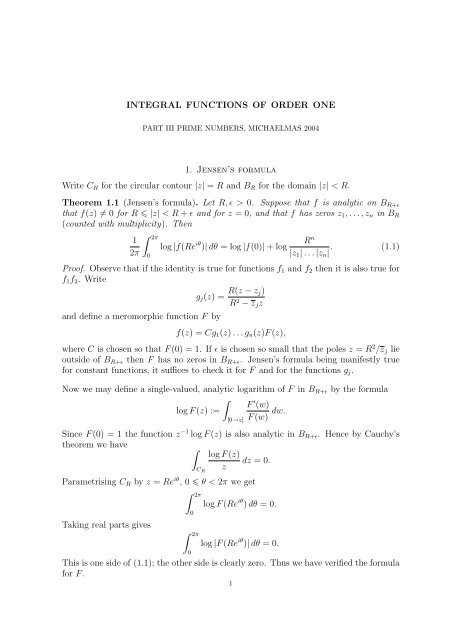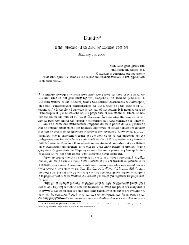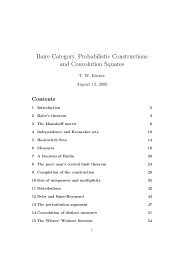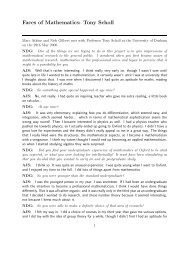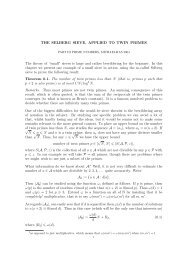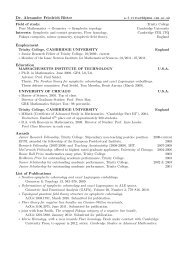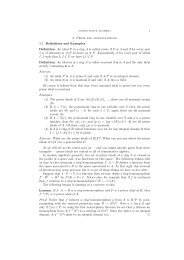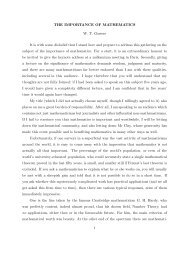INTEGRAL FUNCTIONS OF ORDER ONE 1. Jensen's formula Write ...
INTEGRAL FUNCTIONS OF ORDER ONE 1. Jensen's formula Write ...
INTEGRAL FUNCTIONS OF ORDER ONE 1. Jensen's formula Write ...
You also want an ePaper? Increase the reach of your titles
YUMPU automatically turns print PDFs into web optimized ePapers that Google loves.
<strong>INTEGRAL</strong> <strong>FUNCTIONS</strong> <strong>OF</strong> <strong>ORDER</strong> <strong>ONE</strong><br />
PART III PRIME NUMBERS, MICHAELMAS 2004<br />
<strong>1.</strong> Jensen’s <strong>formula</strong><br />
<strong>Write</strong> CR for the circular contour |z| = R and BR for the domain |z| < R.<br />
Theorem <strong>1.</strong>1 (Jensen’s <strong>formula</strong>). Let R, ɛ > 0. Suppose that f is analytic on BR+ɛ<br />
that f(z) �= 0 for R � |z| < R + ɛ and for z = 0, and that f has zeros z1, . . . , zn in BR<br />
(counted with multiplicity). Then<br />
1<br />
2π<br />
� 2π<br />
0<br />
log |f(Re iθ )| dθ = log |f(0)| + log<br />
Rn . (<strong>1.</strong>1)<br />
|z1| . . . |zn|<br />
Proof. Observe that if the identity is true for functions f1 and f2 then it is also true for<br />
f1f2. <strong>Write</strong><br />
R(z − zj)<br />
gj(z) =<br />
R2 − zjz<br />
and define a meromorphic function F by<br />
f(z) = Cg1(z) . . . gn(z)F (z),<br />
where C is chosen so that F (0) = <strong>1.</strong> If ɛ is chosen so small that the poles z = R 2 /zj lie<br />
outside of BR+ɛ then F has no zeros in BR+ɛ. Jensen’s <strong>formula</strong> being manifestly true<br />
for constant functions, it suffices to check it for F and for the functions gj.<br />
Now we may define a single-valued, analytic logarithm of F in BR+ɛ by the <strong>formula</strong><br />
�<br />
F<br />
log F (z) :=<br />
′ (w)<br />
F (w) dw.<br />
[0→z]<br />
Since F (0) = 1 the function z−1 log F (z) is also analytic in BR+ɛ. Hence by Cauchy’s<br />
theorem we have �<br />
log F (z)<br />
dz = 0.<br />
z<br />
Parametrising CR by z = Re iθ , 0 � θ < 2π we get<br />
Taking real parts gives<br />
CR<br />
� 2π<br />
0<br />
� 2π<br />
0<br />
log F (Re iθ ) dθ = 0.<br />
log |F (Re iθ )| dθ = 0.<br />
This is one side of (<strong>1.</strong>1); the other side is clearly zero. Thus we have verified the <strong>formula</strong><br />
for F .<br />
1
2 PART III PRIME NUMBERS, MICHAELMAS 2004<br />
Turning our attention to the functions gj, note that if |z| = R then<br />
�<br />
�<br />
|gj(z)| = �<br />
z(z − zj)<br />
� R2 �<br />
�<br />
�<br />
− zjz � = <strong>1.</strong><br />
Thus the left-hand side of (<strong>1.</strong>1) equals 0. As for the right-hand side, note that |gj(0)| =<br />
|z1|/R. Thus the right-hand side is zero as well.<br />
Suppose that f is an entire function. <strong>Write</strong> n(r) for the number of zeros of f in Br.<br />
Corollary <strong>1.</strong>2. Let f be an entire function with f(0) �= 0. Then<br />
1<br />
2π<br />
� 2π<br />
0<br />
log |f(Re iθ )| dθ − log |f(0)| =<br />
Proof. By Jensen’s theorem it suffices to check that<br />
log<br />
R n<br />
|z1| . . . |zn| =<br />
� R<br />
0<br />
� R<br />
0<br />
r −1 n(r) dr.<br />
r −1 n(r) dr. (<strong>1.</strong>2)<br />
To do this, list the zeros in BR in order of magnitude, thus |zj| = rj and r1 � r2 �<br />
. . . � rn. For notational convenience set r0 := 0 and rn+1 := R. We have<br />
� R<br />
r −1 n�<br />
� rj+1<br />
n(r) dr = r −1 n�<br />
n(r) = j log(rj+1/rj) = log(R n /r1 . . . rn),<br />
0<br />
as required.<br />
j=0<br />
rj<br />
j=0<br />
2. Integral functions of order one<br />
An integral function of order one is an entire function f : C → C satisfying the bound<br />
|f(z)| = Oɛ(exp(|z| 1+ɛ ))<br />
for all ɛ > 0. We will encounter several such functions in this course. Two examples are<br />
1/Γ(z) and the “super-completed” zeta function ξ(z) which we will encounter in [PN3].<br />
The next lemma allows us to discern the structure of integral functions of order one<br />
which have no zeros. We will use it to prove Theorem 2.2, and it is to fit that need that<br />
we operate under what may seem at this point like unnecessarily weak hypotheses.<br />
Lemma 2.<strong>1.</strong> Suppose that g is an entire function with no zeros which satisfies the<br />
bound<br />
|g(z)| = exp(O(|z| 3/2 ))<br />
for all z ∈ �∞ j=1 CRj , where Rj → ∞ as j → ∞. Then g(z) = eAz+B for some constants<br />
A, B.<br />
Proof. This is a simple variant of a well-known argument used to prove Lioville’s theorem.<br />
First of all note that g has an analytic logarithm h(z) := log g(z), which is subject<br />
to the bound |h(w)| = O(|w| 3/2 ) whenever |w| = Rj for some j. Fix z ∈ C. By Cauchy’s<br />
derivative <strong>formula</strong> we have<br />
h ′′ (z) = 1<br />
�<br />
iπ CR<br />
h(w) dw<br />
(w − z) 3
<strong>INTEGRAL</strong> <strong>FUNCTIONS</strong> <strong>OF</strong> <strong>ORDER</strong> <strong>ONE</strong> 3<br />
provided that |z| < R, which implies that<br />
|h ′′ (z)| � 1<br />
�<br />
|h(w)||w − z|<br />
π<br />
−3 dw. (2.1)<br />
CR<br />
Pick j large enough that z ∈ BRj/2, and apply (2.1) with R = Rj. We have the crude<br />
estimates |w − z| ≫ Rj for w ∈ CRj and, by assumption, |h(w)| ≪ R3/2 j . Also, the<br />
length of the path of integration is 2πRj. Thus estimating (2.1) trivially yields<br />
|h ′′ (z)| ≪ R −1/2<br />
j .<br />
Letting j → ∞ we are forced to conclude that h ′′ (z) = 0, which means that h(z) =<br />
Az + B for some constants A, B.<br />
We turn now to the main result of this set of notes, a structure theorem for integral<br />
functions of order one.<br />
Theorem 2.2. Suppose that f is an integral function of order 1 and that X > <strong>1.</strong> Then<br />
(i)<br />
�<br />
|ρ|�X<br />
|ρ| −1−ɛ ≪ɛ X −ɛ/2<br />
for any ɛ > 0, where the sum ranges over all zeros ρ of f, counted with multiplicity.<br />
(ii) The sum<br />
�<br />
|ρ| −1−ɛ<br />
converges, for any ɛ > 0.<br />
(iii) We have the product representation<br />
for some constants A, B.<br />
f(z) = z r e<br />
ρ�=0<br />
Az+B �<br />
ρ�=0<br />
(1 − z/ρ)e z/ρ<br />
Proof. (i) If f has a zero of order r at 0 then we may divide through by zr . The resulting<br />
function is still entire and has order 1, but now f(0) �= 0. By Corollary <strong>1.</strong>2 we have<br />
� R<br />
0<br />
r −1 n(r) dr = 1<br />
2π<br />
� 2π<br />
0<br />
log |f(Re iθ )| dθ − log |f(0)| ≪ɛ R 1+ɛ<br />
for all ɛ > 0. Writing SR for the number of zeros of f in the annulus R � |z| < 2R, we<br />
therefore have<br />
SR � 1<br />
� 3R<br />
n(r) dr ≪ɛ R<br />
R 2R<br />
1+ɛ/2 .<br />
Thus<br />
�<br />
|ρ| −1−ɛ �<br />
∞�<br />
2 −(1+ɛ)j S2j ≪ɛ<br />
�<br />
2 −ɛj/2 ≪ɛ X −ɛ/2 ,<br />
as required.<br />
|ρ|�X<br />
j:2 j+1 �X<br />
j:2 j+1 �X<br />
(ii) This follows immediately from (i) and a compactness argument (to deal with potential<br />
zeros having |ρ| < 1).
4 PART III PRIME NUMBERS, MICHAELMAS 2004<br />
(iii) A consequence of (ii), with ɛ = 1, is that<br />
�<br />
|ρ| −2 < ∞.<br />
This implies that the function<br />
ρ�=0<br />
F (z) := �<br />
(1 − z/ρ)e z/ρ<br />
ρ�=0<br />
is entire and has zeros precisely at the zeros ρ of f (we will not prove this fact). Thus<br />
g(z) := f(z)/z r F (z) is an entire function with no zeros. We wish to prove that in fact<br />
g(z) = e Az+B , for some constants A, B, and to do this we will apply Lemma 2.<strong>1.</strong> That<br />
lemma requires us to give an upper bound for g, but only on a series of circular contours<br />
CRj ; it clearly makes sense to choose these contours so as to avoid the zeros ρ, and this<br />
is what we do.<br />
For each j � 1, we choose a value of Rj ∈ [2j , 2j+1 ). The number of zeros in the annulus<br />
2j � |z| < 2j+1 is Oɛ(2j(1+ɛ) ), and so (choosing ɛ = 1) there is some R ∈ [2j , 2j+1 ) such<br />
that<br />
|z − ρ| ≫ R −1<br />
(2.2)<br />
for all z ∈ CR and all zeros ρ. Set Rj := R, and throughout what follows suppose that<br />
|z| = R. To get a lower bound on<br />
E := �<br />
(1 − z/ρ)e z/ρ ,<br />
divide the product into three parts<br />
where<br />
and<br />
E1 :=<br />
E2 :=<br />
ρ�=0<br />
E = E1E2E3,<br />
�<br />
0
<strong>INTEGRAL</strong> <strong>FUNCTIONS</strong> <strong>OF</strong> <strong>ORDER</strong> <strong>ONE</strong> 5<br />
the implied constant will depend on the location of any zeros ρ close to 0. Putting all<br />
of this together gives<br />
|E1| ≫ e −2R3/2<br />
. (2.3)<br />
Turning to E2, we have for R/10 < |ρ| � 10R the bound<br />
|1 − z/ρ| � cR −2 ,<br />
this following immediately from (2.2). Furthermore |e z/ρ | � c ′ > 0, and the total number<br />
of ρ under consideration is ≪ɛ R 1+ɛ for all ɛ > 0. Thus we have<br />
|E2| ≫ (cc ′ R −2 ) CɛR1+ɛ<br />
≫ e −R3/2<br />
. (2.4)<br />
To bound E3, observe that by a crude Taylor series expansion one has<br />
for |w| < 1/10. Thus<br />
|E3| > �<br />
|(1 − w)e w | > e −10|w|2<br />
ρ:|ρ|>10R<br />
e −10R2 |ρ| −2<br />
> e −CR3/2<br />
for some C, this last inequality being a consequence of (i).<br />
Putting all this together gives<br />
|E| = |E1||E2||E3| ≫ e −C′ R 3/2<br />
.<br />
It follows immediately that for |z| = R we have<br />
|g(z)| = exp(O(R 3/2 )).<br />
Furthermore, we have proved this for some R = Rj in every dyadic interval [2 j , 2 j+1 ),<br />
j � 0. Thus the hypotheses of Lemma 2.1 are satisfied and we do at last see that<br />
g(z) = e Az+B for some constants A, B.


